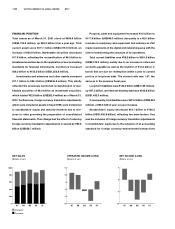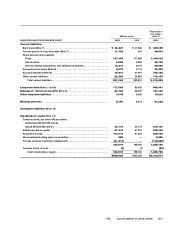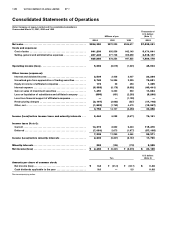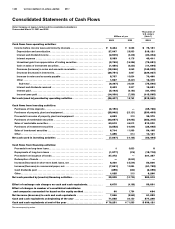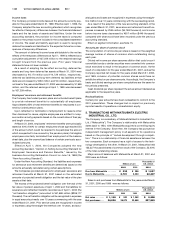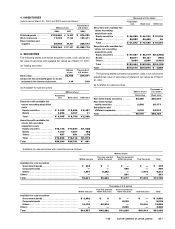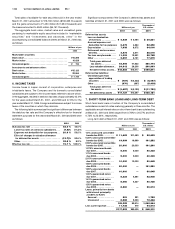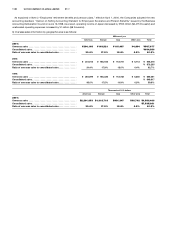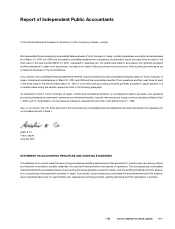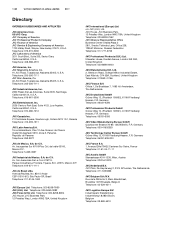JVC 2001 Annual Report Download - page 34
Download and view the complete annual report
Please find page 34 of the 2001 JVC annual report below. You can navigate through the pages in the report by either clicking on the pages listed below, or by using the keyword search tool below to find specific information within the annual report.
Income taxes
The Company provided income taxes at the amounts currently pay-
able for the years ended March 31, 1999. Effective April 1, 1999, the
Company adopted the new accounting standard, which recognizes
tax effects of temporary differences between the financial statement
basis and the tax basis of assets and liabilities. Under the new
accounting standard, the provision for income taxes is computed
based on the pretax income included in the consolidated statement
of income. The asset and liability approach is used to recognize
deferred tax assets and liabilities for the expected future tax conse-
quences of temporary differences.
The amount of deferred income taxes attributable to the net tax
effects of the temporary differences at April 1, 1999 is reflected as a
cumulative adjustment of ¥27,259 million to the retained earnings
brought forward from the previous year. Prior years’ financial
statements have not been restated.
As a result of adopting the tax effect accounting, deferred tax
assets and long-term deferred tax assets at March 31, 2000 were
decreased by ¥6,170 million and ¥14,729 million, respectively,
deferred tax liabilities and long-term deferred tax liabilities at that
date were increased by ¥460 million and ¥44 million, respectively,
net loss for the year ended March 31, 2000 was decreased by ¥1,959
million, and the retained earnings at April 1, 1999 was decreased
by ¥27,259 million.
Employees’ severance and retirement benefits
The Company has funded pension plans and unfunded benefit plans
to provide retirement benefits for substantially all employees.
Approximately 85% of total retirement benefits for employees is cov-
ered by funded pension plans.
Upon retirement or termination of employment for reasons other
than dismissal for cause, eligible employees are entitled to lump-
sum and/or annuity payments based on the current rates of their pay
and length of service.
At March 31, 2000, employees’ retirement benefits were principally
stated at 40% (100% for certain employees whose age reached 55)
of the amount which would be required to be paid (less the amount
which is expected to be covered by the pension plans) if all eligible
employees voluntarily terminated their employment at the balance
sheet date, plus the unamortized balance of certain previously accu-
mulated amounts.
Effective April 1, 2000, the Companies adopted the new
accounting standard, “Opinion on Setting Accounting Standard for
Employees’ Severance and Pension Benefits,” issued by the
business Accounting Deliberation Council on June 16, 1998 (the
“New Accounting Standard”).
Under the New Accounting Standard, the liabilities and expenses
for severance and retirement benefits are determined based on the
amounts actuarially calculated using certain assumptions.
The Companies provided allowance for employees’ severance and
retirement benefits at March 31, 2001 based on the estimated
amounts of projected benefit obligation and the fair value of the plan
assets at that date.
The excess of the projected benefit obligation over the total of the
fair value of pension assets as of April 1, 2000 and the liabilties for
severance and retirement benefits recorded as of April 1, 2000 (the
“net transition obligation”) amounted to ¥41,686 million ($336,177
thousand). The net transition obligation will be recognized in expenses
in equal amounts primarily over 15 years commencing with the year
ended March 31, 2001. Prior service costs are recognized in income
or expenses using the straight-line method over 10 years, and actu-
3. TRANSACTIONS WITH MATSUSHITA ELECTRIC
INDUSTRIAL CO., LTD.
The Company is a subsidiary of Matsushita Electric Industrial Co.,
Ltd. (“Matsushita”). The Company’s relationship with Matsushita
dates back to 1954, when Matsushita acquired a controlling equity
interest in the Company. Since then, the Company has pursued an
independent management policy in all aspects of its operations
based on the principle of “mutual development through competi-
tion.” There is no relationship of financial assistance between the
two companies. Each company has a right of access to the tech-
nology developed by the other. At March 31, 2001, Matsushita held
133,227 thousand shares of common stock of the Company, 52.40%
of the total outstanding shares.
Major account balances with Matsushita at March 31, 2001 and
2000 were as follows:
Thousands of
Millions of yen U.S. dollars
2001 2000 2001
Due from Matsushita . . . . . . . ¥239 ¥298 $ 1,927
Due to Matsushita . . . . . . . . . . 2,781 3,030 22,427
Sales to and purchases from Matsushita for the years ended March
31, 2001, 2000 and 1999 were as follows:
Thousands of
Millions of yen U.S. dollars
2001 2000 1999 2001
Net sales . . . . . . . ¥1,148 ¥900 ¥1,352 $ 9,258
Net purchases . . . 36,898 35,879 30,558 297,565
< 32 VICTOR COMPANY OF JAPAN, LIMITED 33 >
arial gains and losses are recognized in expenses using the straight-
line method over 10 years commencing with the succeeding period.
As a result of the adoption of the new accounting standard, in the
year ended March 31, 2001, severance and retirement benefit ex-
penses increased by ¥595 million ($4,798 thousand), and income
before income taxes decreased by ¥557 million ($449 thousand)
compared with what would have been recorded under the previous
accounting standard.
Effect on segment information, see Note 15.
Amounts per share of common stock
The computation of net income per share is based on the weighted
average number of shares of common stock outstanding during
each year.
Diluted net income per share assumes dilution that could occur if
convertible bonds or similar securities were converted into common
stock exercised to result in the issuance of common stock. As the
result of computation for the year ended March 31, 2001, and as the
Company reported net losses for the years ended March 31, 2000,
and 1999, inclusion of potential common shares would have an
antidilutive effect on per share amounts. Accordingly, the Company’s
basic and diluted earnings per share computations are the same for
the periods presented.
Cash dividends per share represent the actual amount declared as
applicable to the respective years.
Reclassifications
Certain prior year amounts have been reclassified to conform to the
2001 presentation. These changes had no impact on previously
reported results of operations or shareholders’ equity.


